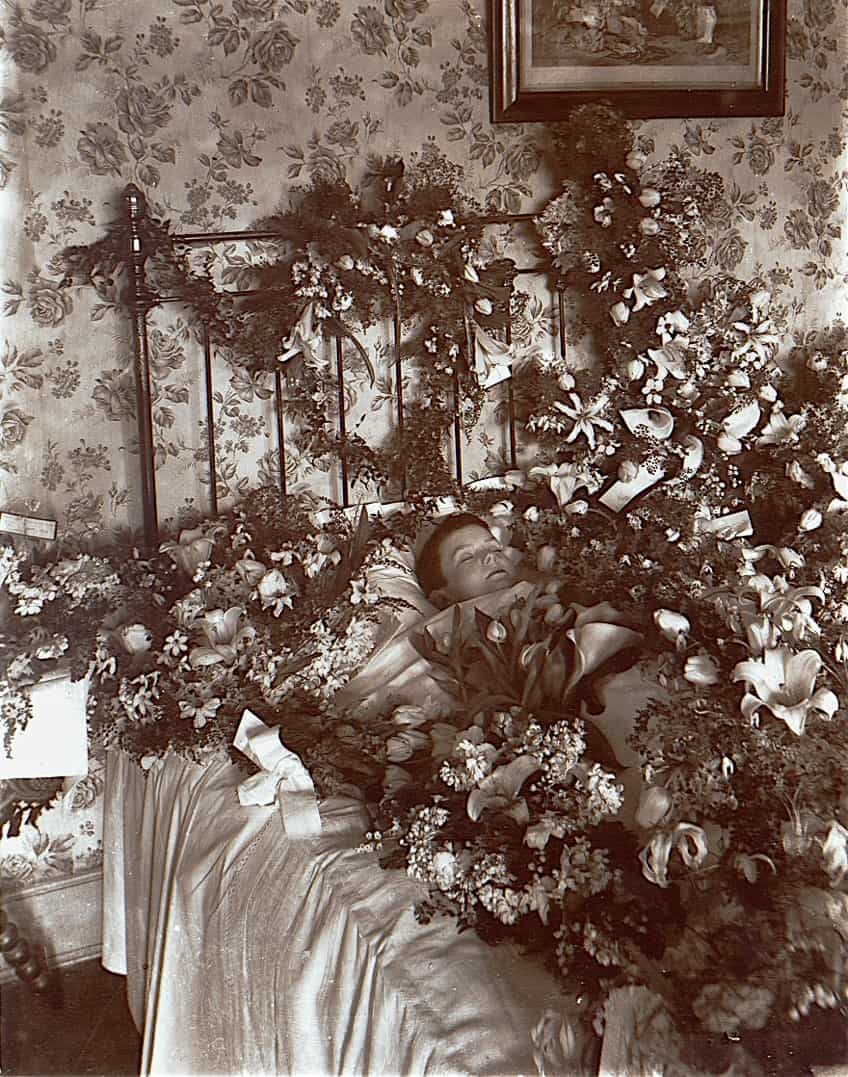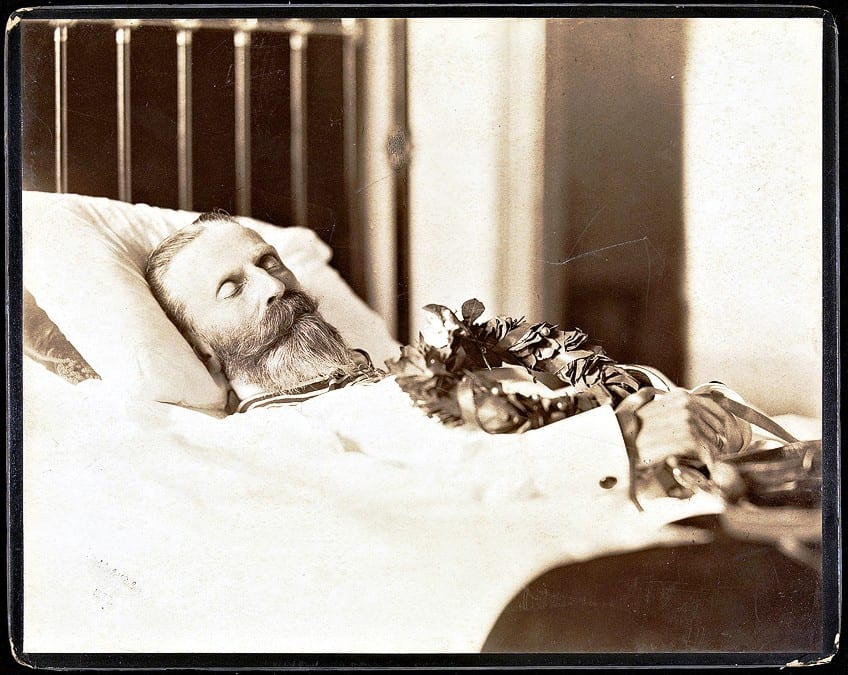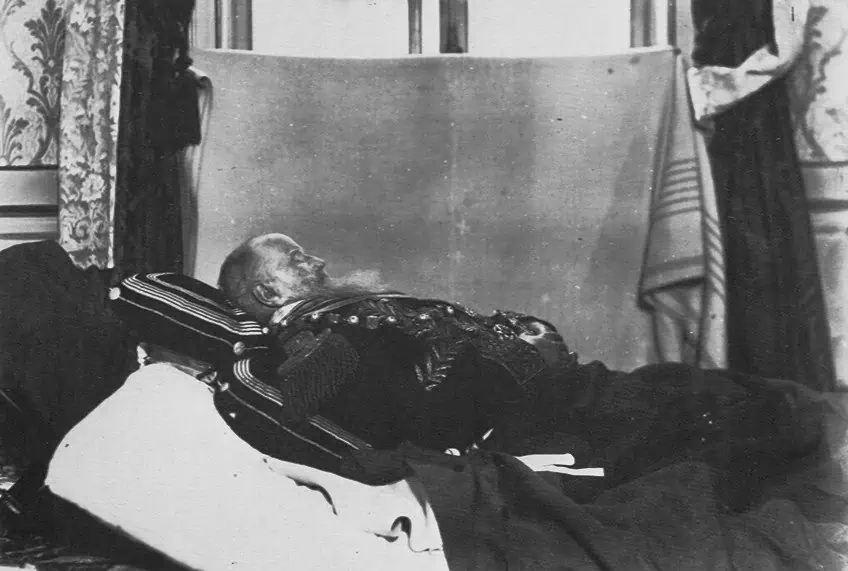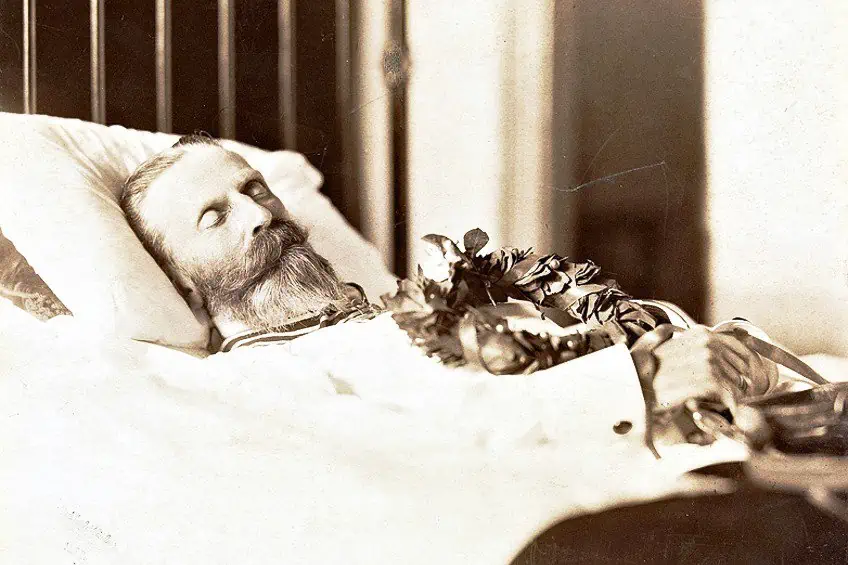Post-Mortem Photography – Moments Frozen in Time
Creepy or artistic? One might easily miss the practice of post-mortem photography and dismiss it as a simple matter-of-fact procedure. In this article, we will introduce you to the practice of post-mortem photography, as well as a brief history of how this practice emerged and how its roots demonstrated a level of creativity sparked by death. Read on for more about this interesting practice!
Contents
An Introduction to Post-Mortem Photography
While post-mortem photography as a genre is not necessarily an art form that freely circulates the art world, it is an intriguing practice known for its morbid nature. What is post-mortem photography? The practice of post-mortem photography involves using photography to capture an image of deceased individuals. Post-mortem photography was practiced more often than one might assume and has its roots in cultures across America and Europe.
The term “post-mortem photography” can also be understood as memorial portraiture or post-mortem portraiture and is often employed in a pathology context.
The roots of the practice find themselves in the early 19th century with the invention of the daguerreotype, which was known as the first accessible form of public photography that allowed those who could not afford the commission price for a portrait, to instead settle for a photography session. Simultaneously, this also allowed families to remember their loved ones by preserving their last moments through post-mortem photography. As the accessibility to photography devices grew, so too was the middle-class able to access post-mortem photography for the same reasons. Photography was a fairly new medium, which required exposure periods that are longer than one might have the ease of capturing an image today. Deceased subjects were thus the perfect models to capture since the exposure period was quite lengthy.

The 19th century also saw the development of hidden mother photography, which was a Victorian style that emerged among photographs of young children and infants. In these photographs, the mother would be present yet not visible to keep her child still for the duration of the exposure period. The development of photography was thus crucial to the development of post-mortem photography, which provided great business for many local photographers, especially with the development of the carte de visite. Carte de visite enabled copies of a single photograph to be distributed via mail to families who were located far and wide. These photographs were the same size as a visiting card and were first patented by André Adolphe Eugène Disdéri in the mid-19th century. One might be surprised to find out that post-mortem photography was incredibly popular up until the 1970s and was a preferred practice by many artists.
In the Contemporary era, post-mortem photography is considered to be an extremely private practice, however, there are still a few public examples of post-mortem photography, including a website called Now I Lay Me Down to Sleep, which features images of stillborn children.
Post-Mortem Photography As Cultural Practice
The history of post-mortem photography is spread across multiple locations around the world, and primarily revolved around the immortalization or preservation of a loved one. In the United States, post-mortem photography was not as publicly discussed by the 1970s and the last trend in post-mortem photography in the USA was a composition that included the deceased among the living or surrounding the coffin. The practice of post-mortem photography is grim, yet its place as a cultural practice is interesting to note.
The United Kingdom saw traditional forms of post-mortem photography through the mediums of painting and drawing to capture images of the dead as far back as the 15th century.
The practice began in Western Europe and spread throughout Europe while first circulating among the upper class. Post-mortem photographers in India photographed the dead bodies of their clients as either proof of their death or as memoirs for the families. Post-mortem photography was also traced to areas such as Iceland and many Nordic countries where the practice declined in popularity due to the diverse development in photography as a medium for art and more than post-mortem or utilitarian purposes. The origin of the practice in Iceland remains unclear, yet its heyday was noted in the early 20th century.

Victorian Post-Mortem Photography
Victorian-era Britain was the hub of post-mortem photography. Between 1860 and the first quarter of the 20th century, post-mortem photography dominated through portraiture. The style of post-mortem portraiture mimicked American portraiture and may be perceived as eerie today. The 19th-century Victorian cultural belief system toward death was quite direct and wasted no time in confronting its sharp and rude reality. The medium of photography was a method of preservation for the remembrance of loved ones and was once customary to include living members of the family alongside recently deceased loved ones in photographs. It is also important to note that throughout the late 18th and 19th centuries, Victorian life was not a piece of cake for many families since the development of new viruses and various epidemics killed off many people.
As such, Victorian life was accustomed to death and many would not expect to live past the age of 40.
An interesting aspect of post-mortem photography was that due to the long exposure time for capturing the persons in the image, many of the deceased models were rendered with more clarity and sharpness than the live sitters. In some cases, the deceased would be placed among their family members and posed in a manner that suggested that they were still alive and part of the photography session. Since many deceased bodies may have had their eyes closed, post-mortem photographers would also paint eyes onto the photographs of the deceased to force life back into the photograph, which may sound somewhat creepy, yet interesting in its widespread acceptance as a cultural norm.

Post-mortem photography was also understood as memento mori photographic portraiture, which is a more artistic lens that one can employ to lessen the clinical nature of post-mortem photography. The concept of memento mori existed for many centuries and was founded on its translation of “remember your mortality” and is a reminder of the fact that all humans will eventually die. If diseases and epidemics did not confront the public with death in a jarring manner, art and photography as a medium eased the consumption and acceptance of death for many. With the development of better healthcare systems and treatments for the general public, post-mortem photography declined since it relied on death as the main source of its creativity.
The rapid development of cheaper tools for photography also meant that families had more access to the medium, resulting in more photographs that captured their loved ones while they were alive.
Poses and Props
The practice of post-mortem photography was well-thought-out and included considerable planning when it came to treating the deceased in a dignified manner. This does not mean that the photographer did not get creative with capturing grief and a final moment of consolation with Victorian families. Real Victorian death photos often featured the deceased propped up in a variety of stoic poses and positions that implied a last shot at capturing their life. Specific tools such as posing stands would help prop up the deceased for exposure periods, which took between half an hour and an hour to capture.

According to other sources, many post-mortem photographers were equipped with props such as “posable corpse arms” and posing stands crafted using cast iron. There are many hoax images and histories concerning the validity of Victorian post-mortem photos that may confuse those interested, however, it is clear that the practice did exist as both a cultural practice and a derivative artistic practice.
Popular Post-Mortem Photographic Types
The invention of the daguerreotype allowed for a significantly decreased exposure period, with the longest exposure period lasting up to a minute and a half. One might easily label this “long exposure” due to the quick nature of the way we can photograph today. By the 1850s, exposure time lasted only a few seconds.
Below, we will look at the different photographic types used in the history of post-mortem photography.
Daguerreotype
The daguerreotype was the first photographic type used for post-mortem photography and was highly popular between 1839 and 1860. A daguerreotype was developed using a copper plate, coated in silver, and exposed to light. The copper plate would then be processed over hot liquid mercury and fixed in a solution of sodium thiosulfate or salt.

Ambrotype
Another photographic type called an ambrotype was popular between 1854 and 1865 and was created using a glass plate instead of copper. The plate would be coated in a collodion and silver nitrate solution and then exposed to light. After the light exposure stage, the plate would be developed using an iron sulfate-based mixture and fixed using sodium thiosulfate.
This method was considered to be cheaper than the daguerreotype yet did not last long in the practice of post-mortem photography.
Tintype
A tintype refers to a plate created from treated iron, which is coated in a mixture of collodion and then submerged in a silver nitrate solution. The iron plate is then exposed to light, developed in a mixture of iron sulfate, and finally fixed using a potassium cyanide mixture. This type of photographic method was equally as popular as daguerreotype photography and lasted up until the mid-20th century.
Silver Gelatin Print
The silver gelatin print method is one of the most well-known methods, which is still popular today. Silver gelatin prints emerged around the early 20th century and involved the use of negative film stock that is developed and then transferred onto paper.
Examples of Post-Mortem Photos
Post-mortem photography was more of a service than an art practice that was offered by commercial studios. One of the aims of post-mortem photos was to create a photo that was as peaceful as possible. One of the most common poses in post-mortem photography includes the last sleep pose, which describes a position where the deceased is photographed in repose with their eyes closed.

Other compositions included poses where the deceased model was physically presented as seated in a chair or mimicking a life-like pose. It was also common to find images of deceased children and babies cradled by their mothers. Below, we will look at a few examples of real Victorian death photos that illustrate the different poses and photographic techniques used by 19th-century post-mortem photographers.
Hand-painted Eyes on Infant; Tintype (c. 1870)
| Artist Name | Unknown |
| Date | c. 1870 |
| Medium | Tintype |
| Dimensions (cm) | Unavailable |
| Where It Is Housed | Burns Archive via HIstory.com |
This eerie image of an infant seated in an upright position is bizarre in its superficial nature of constructed life. The tintype photograph portrays a deceased child with hand-painted eyes and is a tragic attempt at reinserting the illusion of life back into the lifeless body of the child. The eyes were painted in such detail that they seem almost real, yet one can tell that the photo appears unnatural for the lifelike color of the child’s eyes contrasted by the pale skin of the deceased.
The act of mourning was complex in Victorian England and was popularized after Queen Victoria’s oath to only wear black after the death of her husband.
The recreation of lifelike images as part of the Victorian grieving culture was somewhat disturbing, however, the commercial aspect of grieving culture soared through the production of personalized jewelry and other sentimental objects featuring strands of hair from the deceased. These mementos were objects created for a physical remembrance above and beyond the photograph that could be carried by an individual wherever they journeyed to.
Sollitt; Two Views of a Child in a Casket (c. 1880 – 1890)
| Artist Name | Unknown |
| Date | c. 1880 – 1890 |
| Medium | Cabinet cards |
| Dimensions (cm) | Unavailable |
| Where It Is Housed | Mark A. Anderson Collection of Post-Mortem Photography, William Clements Library, University of Michigan, United States |
These two cabinet cards portray a deceased full-body portrait of an infant in an open casket with eyes that were most likely painted on. The creation of cabinet cards meant that information and memorabilia of the deceased person could be disseminated with ease if family members could not attend the funeral. It is unclear who the child in the portrait was, however, the post-mortem photo belongs to the Mark A. Anderson Collection of Post-Mortem photography.
Along with many other real Victorian post-mortem photos from the mid-19th to the early 20th centuries. Post-mortem photos of individuals who were considered to be holy were also in circulation throughout the Victorian era and were most popular among the oriental Orthodox Christians and the Eastern Catholic and Orthodox Christians.
Dog in Simple Coffin (c. 1920 – 1930)
| Artist Name | Unknown |
| Date | c. 1920 – 1930 |
| Medium | Silver gelatin print |
| Dimensions (cm) | Unavailable |
| Where It Is Housed | Mark A. Anderson Collection of Post-Mortem Photography, William Clements Library, University of Michigan, United States |
This silver gelatin print of a deceased dog is an example of a post-mortem photo of a beloved pet and shows just how much the owners cherished their furry friend. The photo captured the dog’s full body in a casket for a last glance at the creature’s peaceful resting demeanor. The function of post-mortem photos as tools for the remembrance of the dead extends the function of photography.
It also sheds light on the value that the development of photography had on the progression and change in cultural preferences concerning a culture’s collective view and treatment of the dead.
Photography as a tool to democratize images of death may today sound strange and perhaps questionable to the ethics of circulating images of deceased people, but the truth of the Victorian post-mortem photography era was relevant to its period and social experience of grief. Grief thus breeds creativity in times of despair and disease and highlights the longing for presence.
Images of the dead may seem socially odd or unacceptable for public circulation today, but it is worth taking note of the relationships that post-mortem photography and Victorian England created between the society it existed in and their adjustment to periods of distress caused by death and disease. We hope that this article on post-mortem photography has been insightful, and has broadened your view of death and its relationship with mediums like photography in art history.
Frequently Asked Questions
What Is Post-Mortem Photography?
Post-mortem photography, also called post-mortem portraiture and memorial portraiture, refers to photos that are captured after a person dies. The practice of post-mortem photography originated alongside the development of photography, and was employed to document images of deceased loved ones as memorial tokens for many families.
Is Post-Mortem Photography Still Practiced?
Post-mortem photography is not as widely practiced in public as it was in the past due to changes in societal preferences. Post-mortem photography is currently a privately practiced genre of photography, most commonly found in pathology contexts.
How Can You Identify a Post-Mortem Photograph?
There are many fake post-mortem images on the internet, however, one can identify a post-mortem image by examining the models in the image and searching for signs of death. The deceased individual would also appear posed in a manner that is unnatural via props, or have their eyes painted. Other signs include searching for indications that suggest someone is supporting the figure’s weight.
Jordan Anthony is a Cape Town-based film photographer, curator, and arts writer. She holds a Bachelor of Art in Fine Arts from the University of the Witwatersrand, Johannesburg, where she explored themes like healing, identity, dreams, and intuitive creation in her Contemporary art practice. Jordan has collaborated with various local art institutions, including the KZNSA Gallery in Durban, the Turbine Art Fair, and the Wits Art Museum. Her photography focuses on abstract color manipulations, portraiture, candid shots, and urban landscapes. She’s intrigued by philosophy, memory, and esotericism, drawing inspiration from Surrealism, Fluxus, and ancient civilizations, as well as childhood influences and found objects. Jordan is working for artfilemagazine since 2022 and writes blog posts about art history and photography.
Learn more about Jordan Anthony and about us.
Cite this Article
Jordan, Anthony, “Post-Mortem Photography – Moments Frozen in Time.” artfilemagazine – Your Online Art Source. October 18, 2023. URL: https://artfilemagazine.com/post-mortem-photography/
Anthony, J. (2023, 18 October). Post-Mortem Photography – Moments Frozen in Time. artfilemagazine – Your Online Art Source. https://artfilemagazine.com/post-mortem-photography/
Anthony, Jordan. “Post-Mortem Photography – Moments Frozen in Time.” artfilemagazine – Your Online Art Source, October 18, 2023. https://artfilemagazine.com/post-mortem-photography/.



